Original paper : Yves Gingras, « L’évolution des collaborations scientifiques entre le Québec, le Canada et l’Union européenne (1980-2009) », Globe, vol. 14, no. 2 (2011): 185–197. Read
Translated by Peter Keating with the kind permission of Globe. Revue internationale d’études québécoises and Yves Gingras.
The most striking and, indeed, essential feature of science is without doubt its international dimension. Scientific knowledge seeks, by definition, to be universal. It is therefore not surprising that international scientific exchanges have deep roots since they are generated by the internal dynamics of science that pre-dates state science policies that explicitly attempt to stimulate exchange through formal programs of cooperation [1].
One way to measure the evolution of scientific collaborations between researchers is to use the bibliographic data provided by the Science Citation Index, now incorporated in the “Web of Science’” which contain the names of all the authors and institutional addresses of the articles identified annually in the more than 7,300 of the world’s most cited scientific journals. Knowing the country of origin of researchers, we can calculate the proportion of scientific publications produced through international collaboration [2].
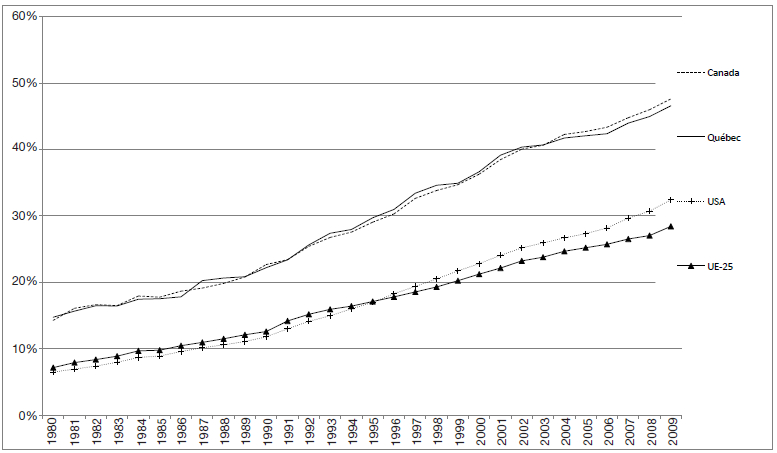
As Figure 1 indicates, the proportion of scientific articles [3] Quebecers and Canadians have written in collaboration with researchers from other countries has increased steadily, from 15% in 1980 to more than 45% in 2009. It can also be seen that Quebec has undergone the same evolution as Canada whereas the proportion of articles written in international collaboration by researchers in the 25 countries members of the European Union is almost two times smaller even though it has followed a parallel, albeit slower, path [4]. Considered as a single entity, the EU-25 has maintained almost the same level of international collaboration as the United States and has evolved similarly, from 7% in 1980 to 28% in 2009. There is, in fact, an inverse relationship between a country’s population and its level of international collaboration. In general, the less populous a country, the greater the need to go beyond national borders to find the necessary expertise for collaboration in a given area. The high level of international collaboration maintained by Quebec and Canada is thus related to their relatively small populations as compared to that of the United States and the European Union.
Inter-provincial and Intra-EU Scientific Relations
Given that Canada is composed of provinces, it is useful to compare interprovincial Canadian collaborations (intra-Canadian) with collaborations between researchers of the member countries of the EU.
What is striking about Figure 2 is the fact that while the level of inter-provincial collaboration within Canada is identical to that of intra-EU collaborations during the first half of the 1980s, we then observe something like a “takeoff” in intra-EU-25 collaborations around 1989. If we limit ourselves to the EU of 1995 and its 15 members, the same trend can be observed although the “take-off” occurs somewhat later, in 1992. This difference suggests that the 10 countries that became members of the EU after 1995 were more scientifically dependent on other members of the EU and that researchers in these countries already entertained collaborative networks prior to the implementation of programs promoting such collaborations. The data also suggests that the European research programs that supported projects implicating researchers from more than one member country of the EU had a significant impact [5]. Although the overall budget for research programs in Europe since 1984 has remained limited (less than 5% of the total R&D for EU countries), it is possible that they have had an incentive effect [6]. By contrast, Canada’s Networks of Centers of Excellence Program (NCE) founded in 1989 does not seem to have stimulated as much growth in inter-provincial collaborations. Nonetheless, one thing is certain: international collaborations are always more intense than interprovincial collaborations [7]. This phenomenon can be explained by the fact that there is, in general, a much larger pool of foreign researchers than local researchers, be it a country or a province, and that the highly-specialized nature of research means that any given researcher has a much greater chance of finding a colleague with which to collaborate in the rest of the world than in his or her own country (or province).
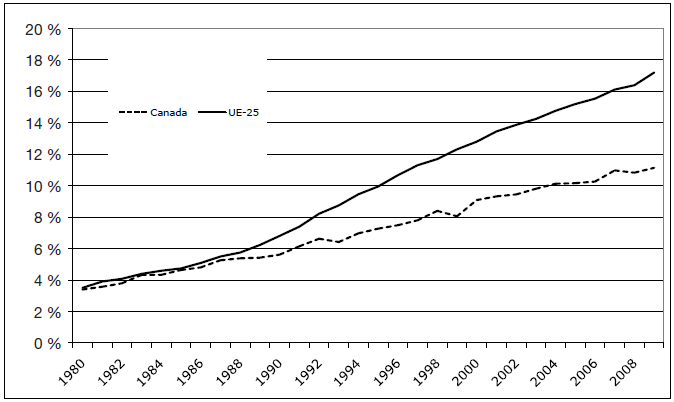
Quebec Is the Center of Canada-Europe Scientific Exchanges
Figure 3 shows the evolution of the relations of researchers from different Canadian provinces with their counterparts in the EU. Strikingly, Quebec has maintained the most intense links with Europe since the beginning of the 1980s, although the participation of Ontario, Alberta and British Columbia has grown steadily since the beginning of the 1990s. Consequently, the presence of EU member countries in Quebec articles written in collaboration has increased from about 45% at the beginning of the 1980s to more than 50% at the end of the 2000s. Unsurprisingly, the dominant trend in Anglophone provinces has been to forge cooperative links with the United States and Anglo-Saxon countries. As a result, as we see in Figure 4, Quebec is last in terms of the proportion of its publications written in collaboration with U.S. researchers. This proportion is based on the number of articles written in international collaboration and not on the total number of articles. This ratio, which oscillates around 47%, remained relatively stable until 2005 and then dropped slightly to 45% during the second half of the 2000s. British Columbia has also seen its share of U.S. collaborations decrease during this period as the province increased its links with Asia (curves not shown) and Europe (Figure 3). Together, the EU and the USA account for almost all of the international collaborations of the Canadian provinces.
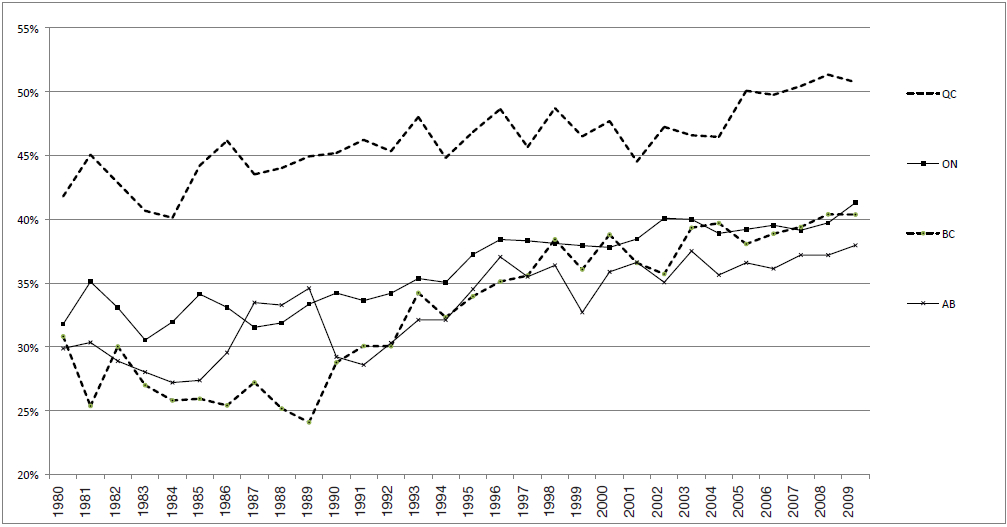
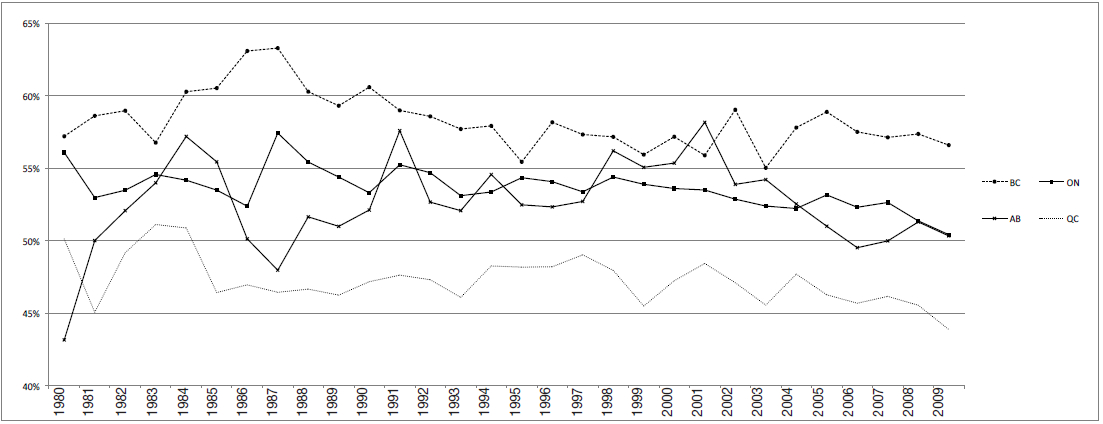
Of course, the scientific collaborations of different Canadian provinces are not distributed evenly between the 25 member countries of the EU and researchers in each province maintain special relations with counterparts in specific EU countries. As Table 1 shows, Quebec is predictably most closely linked with France whereas the other provinces favor the United Kingdom. The fact that Poland is part of Alberta’s collaboration network suggests that local networks often have a historical basis: Alberta is home to a large Eastern European population. For purposes of comparison, we have also displayed the level of collaboration with the United States during the same period in order to reiterate the fact that this country remains by far the most important partner for Quebec and Canadian researchers. On the whole, however, relationships are fairly stable and it is essentially the same countries that are involved. There is in fact a very high concentration of international collaborations: 3 countries (United Kingdom, France, Germany) account for 55% of all collaborations and 6 countries (obtained by adding Italy, the Netherlands and Sweden) account for 75% of the total. Finally, 13 countries out of 25 accounted for 93% of all scientific collaborations. Such concentration reflects the uneven level of development of scientific research institutions within the European Union. More detailed analyses show that collaborations vary slightly according to discipline: a province’s collaborations with a given country might differ in chemistry, physics or engineering [11]. In Quebec’s case, for example, whereas approximately 20% of its international collaborations are with France, for the whole of the sciences, this proportion climbs to 25% in chemistry and falls to 16% in mathematics.
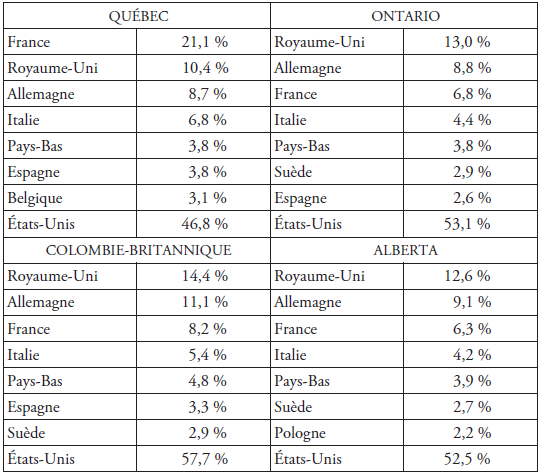
Note, furthermore, that the intensity these links varies according to the country and the provinces. As shown in the Figure 5, linkages are less intense in small Canadian provinces (Saskatchewan, Manitoba, Newfoundland, Nova Scotia) that lie at the edges of international networks. There is also a greater dispersal of collaborations for the larger provinces with the smaller ones tending to focus on a particular country. If we increase the minimum threshold of collaboration to 250 collaborations over the period 2001-2005, the network becomes more rarified as can be seen in Figure 6. In this instance, the centrality of Quebec and Ontario is even more evident.
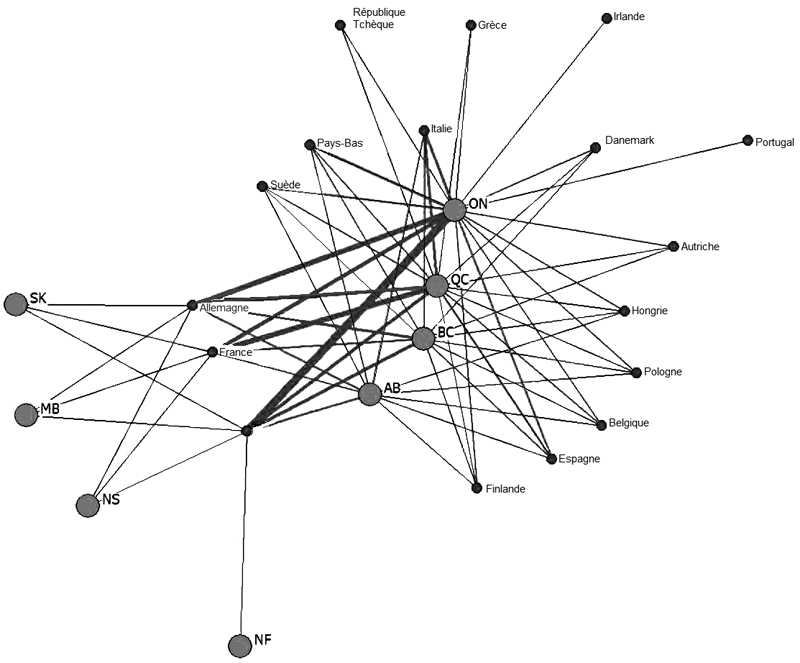
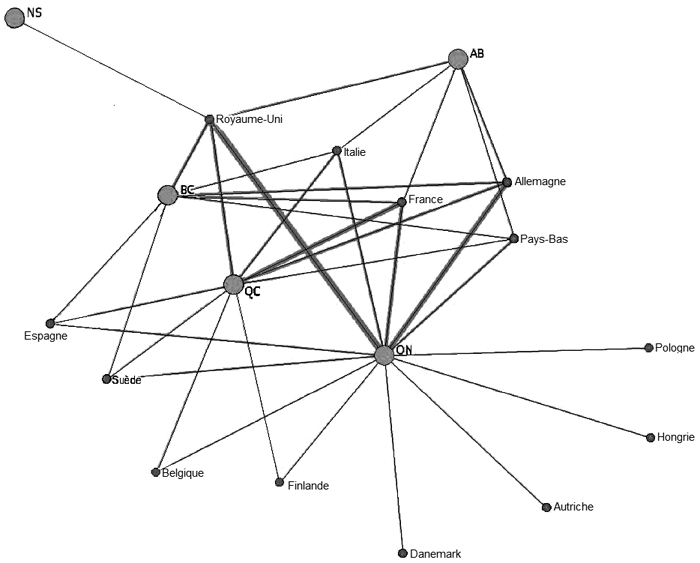
Conclusion
This quantitative analysis of formal scientific collaborations between Quebec and Canadian researchers and European researchers between 1980 and 2009 should not obscure the fact that there are also informal scientific networks linking researchers that do not result in the production of joint publications. As we have shown elsewhere [15], this is more often the case in the social sciences and humanities. However, the proportion of publications written in international collaboration remains an excellent indicator of global trends in the internationalization of scientific research.
Indeed, the mapping of collaborations can be visualized on different scales: provinces, disciplines and even universities. At the largest scale (that of the country), we see that international scientific collaborations between researchers did not await the implementation of government programs to get going and that the current discourse on the “internationalization” of universities and “globalization” are only the reflection -at the level of formal links between institutions or countries- of something that has been underway for quite some time with regards to direct relations between researchers. As suggested above, however, it is possible that formal programs can reorient networks by favoring geographical directions -intra-Europe for example- or even by creating new networks by encouraging researchers to collaborate with colleagues in other countries with whom they were not already collaborating in order to meet the requirements of research grant programs. This is the case with the European Framework Programs as well as with Quebec Fund for Research on Society and Culture (FQRSC). In 2010, the latter worked with France National Research Agency (ANR) to promote joint France-Quebec research teams, thus providing a recent example of “top-down” plans and programs that can orient international collaborations. Relations between researchers, both at the national and international level, should, however, be based on the social networks built by researchers themselves according to their own common problems and following their sometimes-fortuitous encounters during international scientific meetings or as the result of reading convergent or complementary work that then results in a pooling of often expensive or rare resources. It is therefore unsurprising to observe that in the case of Canada-EU scientific relations collaborations are concentrated in countries with the highest scientific development and that each province has established a unique network of links that reflects its history, culture and scientific specialties. Thus, within Europe, Quebec researchers work first and foremost with their French counterparts while the other Canadian provinces concentrate instead on the United Kingdom. Formal programs of cooperation may, however, counter such trends toward concentration by creating situations that would not otherwise occur. Programs of cooperation aimed to create new networks will, however, have a greater chance of success if they are based on a thorough knowledge of the networks already existing between researchers. In other words, forced marriages rarely last…
This analysis the relations between Quebec and Canadian researchers and their counterparts in EU countries clearly shows that bibliometrics (i.e. the quantitative analysis of scientific publications and their characteristics) allows one to create a useful and illuminating map of international scientific relations and their time evolution at the scale of countries, provinces and institutions. This type of analysis may not only be useful for evaluating the effects of internationalization policies, but may also serve as a tool to guide them so that they are consistent with the choice of researchers who, following the logic of their fields of specialization, weave international networks so as to maximize their chances of success in their research.
Notes
[1] Yves GINGRAS, “Les formes spécifiques de l’internationalité du champ scientifique”, Actes de la recherche en sciences sociales, 141-142, March, 2002, pp. 31-45.
[2] All data used in this article come from the databases of the Observatory of Science and Technology (OST) at UQAM that in turn are derived from the Clarivates’ Expanded Science Citation Index. I would like to thank Vincent Larivière and Alain Couillard for having produced the tables and figures. Thanks also to Teresa Patricio and reviewers for their comments and suggestions. The proportion of international collaborations is calculated in the following manner: the number of articles having at least one address from a country other than Canada (or the EU), divided by the total number of Canadian (or EU) articles. Because an article may be written by authors from more than two countries, the total of the percentages for a country may exceed 100% because we calculate articles (and not a fraction of an article) for each participating country.
[3] We consider here only the natural sciences, engineering and the biomedical sciences. We have excluded the social sciences and the humanities for which the levels of international collaboration are much lower, due in part to the fact that multiple author publications are less frequent in these disciplines. In addition, unlike the objects of the natural sciences, those of the social and human sciences are more local and less amenable to collaborative studies. For a comparison of the practices of collaboration in the natural sciences and the social and human sciences, see: Vincent LARIVIÈRE, Yves GINGRAS and Éric ARCHAMBAULT, “Canadian collaboration networks: a comparative analysis of the natural sciences, social sciences and the Humanities”, Scientometrics, Vol. 68, No. 3, 2006, pp. 519-533.
[4] To simplify, we have included the 25 member countries of the EU circa 2007. It would have been much more complicated to take account of the fact that the number of member countries has varied considerably over the course of the study period, from 9 in 1973, to 12 in 1986, 15 in 1995 and finally to 25 in 2007. Moreover, since most of the new members are not responsible for a large number of collaborations, their inclusion from the outset does not change the overall trends.
[5] T. LUKKONEN, “Old and new strategic roles for the European Union framework program”, Science and Public Policy, Vol. 28, No. 3, June 2001, pp. 205-218.
[6] For an overview of the evolution of these programs, see Maria Teresa PATRICIO, “EU research and technological development programs: what role for the Social Sciences and Humanities”, Portuguese Journal of Social Science, Vol. 3, No.1, 2004, pp. 49-68.http://journals.sagepub.com/doi/abs/10.1177/1028315309337932
[7] Vincent LARIVIÈRE, Yves GINGRAS and Éric ARCHAMBAULT , op. cit.
[8] Based on the total number of the articles published by Canada and EU-25
[9] Based on the number of articles each province has written in international collaboration
[10] Based on the total number of articles from each province written in international collaboration.
[11] For the analysis of international Canadian collaborations by discipline, see Yves GINGRAS, Benoît GODIN, and Martine FOISY, “The internationalization of university research in Canada”, in Sheryl Bond and Jean-Pierre Lemasson [eds.], A New World of Knowledge: Canadian Universities and Globalization (Ottawa, IDRC, 1999), pp. 81-103.
[12] Based on each province’s total number of articles written through international collaboration. The total may exceed 100% because the same article can be authored by researchers in several countries.
[13] Links are listed for 100 or more collaborations. The thickness of the link is proportional to the number of collaborations between each pair of linked countries.
[14] Links are listed for 250 or more collaborations). The thickness of the link is proportional to the number of collaborations between each pair of linked countries.
[15] Yves GINGRAS, Benoît GODIN, and Martine FOISY, loc. cit.

